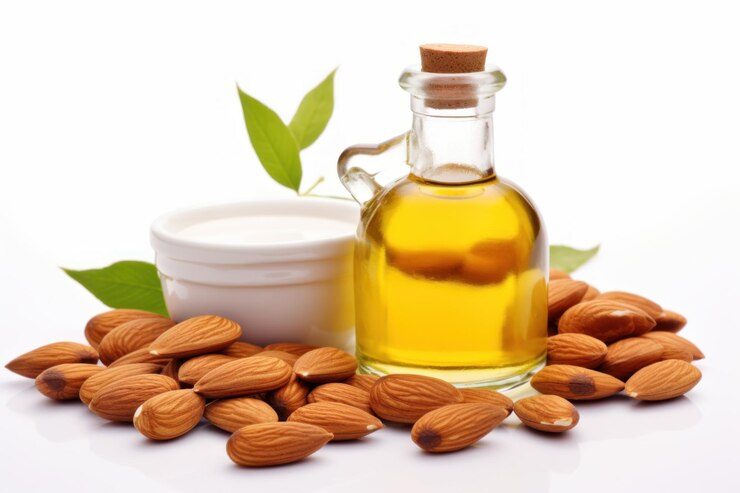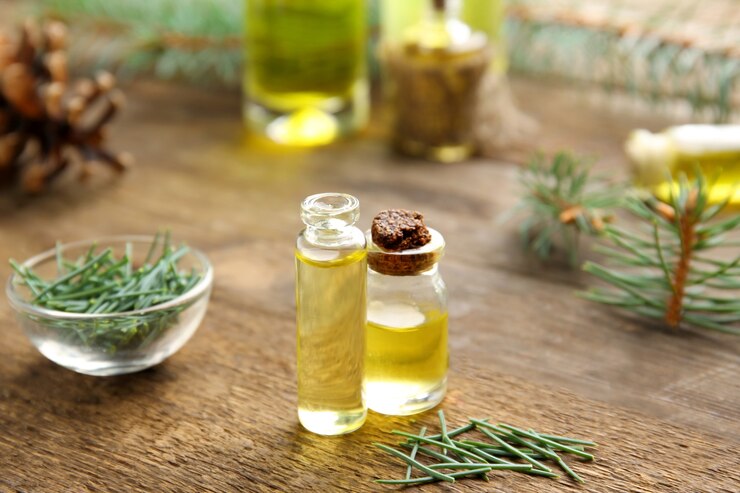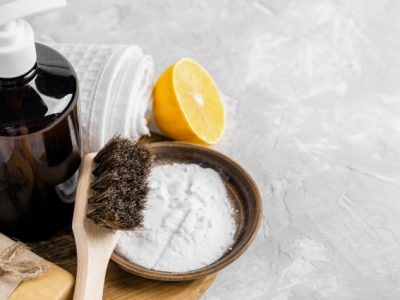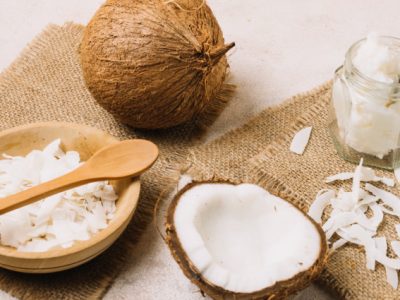Rosemary oil and almond oil are two natural plant-based oils that offer exceptional nourishment for your hair and scalp. Used together, rosemary and almond oil make a potent combination that stimulates circulation, strengthens strands, adds shine, prevents thinning, and encourages healthy new growth.
This comprehensive guide will cover everything you need to know about rosemary and almond oil for optimal hair care. Learn about the origins, extraction methods, nutritional profiles, scalp and hair benefits, safe usage, recipe blends, and creative ways to use rosemary oil and almond oil for lustrous, enviable locks. Get ready to unlock the secrets of these ancient botanical oils!
Chapter 1: The Origins and History Of Rosemary Oil for Hair
The fragrant herb rosemary has been used for centuries for both culinary and medicinal purposes. Native to the Mediterranean region, Ancient Egyptians, Romans, and Greeks valued rosemary for its diverse healing properties Using Ayurvedic medicine and traditional Chinese medicine, rosemary was believed to stimulate circulation, boost memory retention, relieve muscle aches, and purify the body.
Rosemary oil has been steam distilled from the leaves of the rosemary plant since at least the 14th century in France and Spain. Its woody, evergreen aroma was said to strengthen the memory and uplift the spirit.
By the 17th century, rosemary oil had earned a reputation in Europe for stimulating hair growth and preventing premature balding. In fact, rosemary oil is still often marketed today under the traditional name “oil of youth” for its anti-aging hair benefits.
When applied to the scalp, rosemary oil’s stimulating circulation and anti-inflammatory properties transform lackluster hair by improving growth. It conditions dry strands and gives hair an added body and shine.
Chapter 2: How Rosemary Oil Benefits Hair Health
Here is a more in-depth look at the top ways rosemary oil boosts scalp and hair vitality:
– Improves circulation – nourishes follicles by increasing blood flow.
– Stimulates growth – compounds help spur hair into active growth phase.
– Anti-inflammatory – reduces scalp itchiness and irritation.
– Antibacterial – prevents dandruff and bacterial fungal scalp infections.
– Conditions hair – adds smoothness, shine, and strength to damaged strands.
– Prevents thinning – Antioxidants protect follicles and prevent miniaturization.
– Adds volume – improves texture and coats strands for fuller appearance.
– Slows graying – nourishes melanin in hair follicles.
– Cleanses scalp – purifying properties eliminate oil and gunk buildup.
With its concentrated healing botanical oils and compounds, it’s clear why rosemary oil is a star ingredient for hair care!
Chapter 3: How Is Rosemary Essential Oil Extracted?

Rosemary essential oil is extracted via steam distillation of the leaves and flowering tops of the rosemary plant (Rosmarinus officinalis). During this process, rosemary leaves are exposed to pressurized steam, causing the oil compounds to evaporate. The oils are then collected and condensed back into liquid form.
It takes a staggering 50-60 pounds of rosemary leaves to produce just 1 ounce of essential oil! This labor-intensive process is reflected in rosemary oil’s higher cost compared to other essential oils. But a little goes a long way.
Always look for 100% pure steam-distilled rosemary essential oil. Avoid oils that contain synthetic additives or fragrance chemicals. For maximum hair-fortifying effects, pure rosemary oil is best.
Chapter 4: The Key Nutrients And Compounds In Rosemary Oil
What exactly gives rosemary oil its hair-boosting superpowers?
Here is a breakdown of the main nutrients and plant compounds contained in rosemary essential oil:
-Carnosic acid – stimulates growth, prevents oxidative damage
– Carnosol – an antioxidant that protects hair follicles
– Camphor – increases circulation to follicles to spur growth
– Rosmarinic acid – antioxidant with anti-inflammatory benefits
– Linalool – a phytonutrient with soothing, calming properties- Borneol – a stimulant compound that boosts circulation
– Alpha-pinene – improves blood flow to the scalp
– 1,8-cineole – controls oil production and dandruff
– Vitamin A – nourishes the scalp and prevents drynessThis nutrient-packed essential oil helps revive dull, thinning hair by getting to the root of imbalances. Now let’s go over how to use it properly and safely.
Chapter 5: How To Use Rosemary Oil For Healthy Hair
When used topically as part of your hair care routine, rosemary oil offers noticeable benefits for scalp and hair vitality.
Here are some key usage tips:-
– Perform a patch test before initial use to check for allergic reaction.
– Always dilute rosemary oil – mix 3-5 drops with 1-2 tbsp carrier oil before applying to hair.
– Massage diluted oil directly into the scalp and lengths before shampooing.
– For intensive treatment, wrap hair and let sit 30 minutes – to 1 hour before rinsing out.
– Use 1-2 times per week for maintenance and growth support.
– Discontinue use if any irritation or sensitivity occurs. Avoid eye contact.
Be patient – rosemary oil improves hair’s texture, growth, and thickness over time with regular use. Combine with supportive hair care ingredients like biotin, coconut oil, and keratin for added benefits.
Chapter 6: Mixing Rosemary Oil Hair Growth Recipes

One of the easiest ways to use rosemary oil for its hair-fortifying benefits is by combining it with other nourishing carriers and essential oils. Try these recipes:
Growth Elixir Blend:
4 tablespoons castor oil
2 tablespoons almond oil
1 tablespoon rosemary oil
2 teaspoons lemon essential oil
Mix the ingredients together in a small glass bottle. Shake before applying it to the scalp and hair. Massage in and leave on for 1 hour before shampooing out.
Anti-Thinning Oil:
3 tablespoons extra virgin olive oil
1 tablespoon rosemary oil
1 tablespoon basil oil
1 teaspoon cedarwood essential oil
Combine in a bottle and shake to blend. Apply to clean, damp hair focusing on the scalp. Leave on for at least 30 minutes then wash out.
Volumizing & Shine Oil:
2 tablespoons grapeseed oil
1 tablespoon rosemary oil
1 tablespoon argan oil
1/2 tablespoon lavender essential oil
Mix the ingredients in a container and shake. Warm a small amount between palms and smooth over hair lengths. Don’t rinse out.
Scalp Detox Oil:
5 tablespoons almond oil
2 tablespoons rosemary oil
1 tablespoon lemon essential oil
1 tablespoon tea tree essential oil
Mix together and use on the dry scalp before showering. Massage into the scalp for several minutes before rinsing thoroughly.
Chapter 7: The Origins And Uses Of Almond Oil For Hair
Now that you’re acquainted with rosemary oil, let’s get into how almond oil perfectly complements it as part of your hair health regimen.
Almond oil is extracted from raw almonds – the edible seeds of the Prunus amygdalus tree, native to the Middle East and South Asia. Records show almond oil was produced as early as 4000 BC. In Ayurveda, almond oil was revered for its skin and hair-beautifying properties.
The ancient Egyptians blended almond oil with fragrant floral absolutes for perfumed concoctions. Almond oil gained popularity in Europe during the Renaissance era as an essential skin salve ingredient.
When applied topically, almond oil nourishes hair down to the roots and smooths damaged cuticles along the length of strands for silkier texture and shine. Its light consistency makes it ideal for all hair types without leaving heaviness.
Chapter 8: The Nutrients In Almond Oil That Benefit Hair
Here’s a closer look at why almond oil is so beneficial for restoring hair’s health and beauty:
– Vitamin E – powerful antioxidant that protects follicles from damage. – Omega-3 fatty acids – nourish hair with protein for strengthened strands.
– Zinc – a mineral that stimulates circulation and growth.
– Proteins – bond to hair strands to increase elasticity and prevent breakage.
– Monounsaturated fats – smooth split ends by coating the hair shaft.
– Vitamin D – encourages growth and lengthening of the active phase.
– Magnesium – a mineral that prevents hair thinning.
This nutritional profile explains why almond oil is renowned for reducing hair loss and dryness. It’s light enough for all hair types without weighing strands down.
Chapter 9: How Almond Oil Is Extracted

Authentic, high-quality almond oil is cold-pressed from raw almonds. This traditional extraction method maintains the integrity of the oil’s nutrients. No heat or chemicals are used.
Quality is key when selecting almond oil. Look for “cold pressed” and “expeller pressed” on labels. Dark amber glass bottles prevent light exposure. USDA-certified organic, unrefined oil offers the most benefits.
Avoid cheaper refined almond oils, which use solvents that strip away nutrients. Make sure the oil smells fresh and nutty – rancid oils are old or oxidized. Then prepare to nourish your strands!
Chapter 10: Using Almond Oil For Healthy, Strong Hair
Used as part of your regular hair care routine, almond oil offers these benefits:
– Seals split ends – coats and protects the hair cuticle from damage
– Adds silkiness and shine – smooths rough, frizzy hair texture
– Prevents tangles – allows easy detangling, reduces breakage
– Soothes dry, itchy scalp – hydrates and moisturizes
– Protects against heat styling damage – thermal protectant
– Prevents hair loss – vitamin E strengthens follicles against shedding
– Boosts volume – coats each strand to appear thicker- Repairs damage – nourishes and rejuvenates over-processed hairHere are some key ways to use almond oil on your hair properly and safely:- Perform a patch test before initial use to check for nut allergies. – Warm a few teaspoons of almond oil between palms and apply evenly onto damp or dry hair.
– Let sit for 30 minutes to 8 hours before shampooing out.
– Use small amounts on thin hair to avoid greasiness. Rinse thoroughly.
– Apply daily to dry ends or use 1-2 times weekly for deep conditioning.
Chapter 11: Recipes To Use Almond Oil And Rosemary Oil Together
Now let’s check out some great hair health recipes utilizing almond oil and rosemary oil together:
Overnight Scalp Detox:
2 tablespoons almond oil
2 tablespoons castor oil
1 tablespoon rosemary oil
1 teaspoon lemon essential oil
Mix oils in a bottle and massage into scalp before bed. Wrap hair in a towel and rinse in the morning.
Anti-Thinning Hair Mask:
3 tablespoons almond oil
1 tablespoon olive oil
1 tablespoon rosemary oil
1/2 teaspoon cedarwood essential oil
Apply all over scalp and lengths. Let sit 60 minutes then shampoo out. Use 1-2 times weekly.
Damage Repair Treatment:
1 tablespoon almond oil
1 tablespoon argan oil
1 tablespoon honey
1 teaspoon rosemary oil
Combine, warm between hands, and smooth through hair. Leave on 30 minutes before washing out.
Volumizing & Shine Serum:
1 tablespoon almond oil
1 teaspoon rosemary oil
3-4 drops geranium essential oil
Use this light serum on damp hair and don’t rinse out. Air dry as usual.
Dandruff Control:
1 tablespoon almond oil
1 tablespoon sesame oil
1 tablespoon rosemary oil
1 tablespoon tea tree oil massage into scalp.
Let sit 1 hour then shampoo and rinse thoroughly.
Use these recipes 1-2 times per week for nourished, healthy hair! Reduce frequency if hair becomes greasy or weighed down.
Chapter 12: Storing And Shelflife Of Rosemary Oil And Almond Oil

To retain the purity and hair-boosting potency of your oils, be sure to store them properly:
– Keep oils sealed in dark glass bottles away from light, heat, and air exposure.
– Store in a cool, dry cabinet or drawer – not in humid bathrooms.
– Refrigeration can help oils last longer but isn’t required.
– Ideal storage temperature is below 75°F (24°C). When stored optimally, rosemary and almond oils have the following expected shelf life:
– Rosemary essential oil: 2-4 years
– Sweet almond carrier oil: 2-3 years
– Cold-pressed unrefined almond oil: 6-12 months
Discard oils that smell rancid or show signs of oxidation like change in texture or color. Then replace them with fresh bottles and continue enjoying their hair perks!
Chapter 13: Additional Hair Tips When Using Rosemary Oil and Almond Oil
Finally, follow these tips to get the most out of using rosemary and almond oils:
– Perform a patch test before first use to check for any allergic reactions.
– Always mix rosemary oil with a carrier oil like almond before applying to hair.
– Rinse out oils thoroughly with shampoo – don’t leave excessive residue.
– Reduce oil usage on thin or fine hair that becomes greasy easily.
– Apply lighter oils like almond just to midshaft and ends if hair gets oily quickly.- Let rosemary oil soak into scalp for at least 5-10 minutes before rinsing for optimal absorption.
– Give oils 2-3 months of consistent use to notice a real difference in hair quality.
– If hair becomes overly oily or limp, switch to using oils only 1-2 times per week.
Now you’re ready to harness the synergistic power of rosemary and almond oils for shinier, healthier hair growth! These ancient botanical secrets will help strengthen your strands and treat scalp imbalances when used properly. Say hello to your luscious locks reawakened.
Read Also:

















